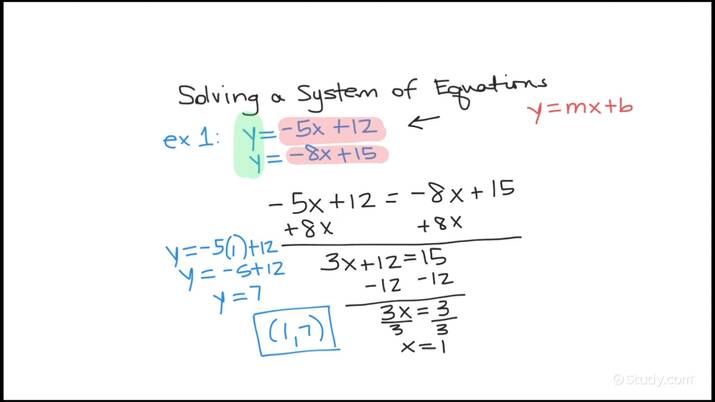Finding Your Way to B: Exploring the Y-Intercept in y = mx + b
The equation y = mx + b is a fundamental building block in algebra, representing a linear relationship between two variables, x and y. This equation defines a straight line on a graph, with its slope (m) dictating the line’s slant and its y-intercept (b) determining where the line crosses the y-axis. This comprehensive guide dives into the concept of the y-intercept (b) in the equation y = mx + b, exploring various methods to find its value and its significance in understanding linear relationships.
Understanding the Y-Intercept: The Key to the Lock
The y-intercept (b) signifies the point where the straight line intersects the y-axis. In simpler terms, it represents the value of y when x is zero (x = 0). Here’s a visual representation:
Imagine a graph with the x-axis representing horizontal movement and the y-axis representing vertical movement. The y-intercept (b) tells you how far you move up (positive b) or down (negative b) from the origin (0, 0) to reach the point where the line crosses the y-axis.
Unlocking the Secrets of B: Different Methods to Find Its Value
There are several methods to find the y-intercept (b) in the equation y = mx + b:
-
The Graphical Method:
- Plot the equation on a graph.
- Locate the point where the line intersects the y-axis (x = 0).
- The y-coordinate of this point represents the value of b.
-
The Substitution Method:
- Set x equal to zero (x = 0) in the equation y = mx + b.
- Simplify the equation to solve for y. The resulting value is your y-intercept (b).
For instance, consider the equation y = 2x + 3. Substitute x = 0:
y = (2 * 0) + 3 y = 0 + 3 y = 3
Therefore, in this equation, the y-intercept (b) is 3.
- The Point-Slope Method:
- If you are given the slope (m) and a point on the line (x1, y1), you can use the point-slope formula to derive the equation of the line, which will then reveal the y-intercept (b).
The Significance of the Y-Intercept: More Than Just a Number
The y-intercept (b) plays a crucial role in understanding and interpreting linear relationships:
- Initial Condition: It represents the initial value of y when x starts at zero. This is particularly useful in scenarios where the x-axis represents time and the y-axis represents a quantity that changes over time. For example, if y represents the population of a city over time (x), the y-intercept (b) would indicate the city’s initial population at time zero.
- Visualizing the Line: Knowing the y-intercept (b) along with the slope (m) allows you to easily graph the equation. The y-intercept provides the starting point on the y-axis, and the slope dictates the direction and steepness of the line.
- Understanding Change: The y-intercept (b) helps differentiate between lines with the same slope. Even if two equations have the same slope (m), their y-intercepts (b) will differ, resulting in lines that intersect at the origin (0, 0) but have different starting points on the y-axis.
FAQ: Demystifying the Y-Intercept
Here are some frequently asked questions to solidify your understanding of the y-intercept (b) in the equation y = mx + b:
- Can the y-intercept (b) be negative? Absolutely! A negative y-intercept indicates the line intersects the y-axis below the origin (0, 0), meaning you move down from the origin to reach the point of intersection.
- What if the equation is not in the form y = mx + b? You can always manipulate the equation to arrive at the slope-intercept form (y = mx + b) to reveal the y-intercept (b).
- How is the y-intercept (b) related to the real-world context of an equation? The y-intercept (b) can represent the starting value of a dependent variable (y) when the independent variable (x) is zero. The specific interpretation depends on the real-world scenario the equation represents.
A Graphical Approach
Here’s how to find the y-intercept (b) using a graph:
- Locate the Axes: Ensure your graph clearly identifies the x-axis (horizontal) and the y-axis (vertical).
- Identify the Line: Distinguish the line you’re interested in from any other lines present on the graph.
- Look for the Intersection: Trace the line until it intersects the y-axis. This point of intersection will have an x-coordinate of zero (0) and a y-coordinate that represents the y-intercept (b).
- Read the Y-Value: The y-coordinate of the intersection point corresponds to the y-intercept (b). Notice whether this value is positive (above the origin) or negative (below the origin).
By employing these methods and understanding the significance of the y-intercept, you’ll be well-equipped to navigate linear equations and interpret the relationships they represent. Remember, the y-intercept (b) serves as a valuable tool for visualizing lines, understanding initial conditions, and differentiating between equations with similar characteristics.






More Stories
Where to Watch USMNT vs Jamaica National Football Team
How I Met My Monster
How Should a Ring Fit